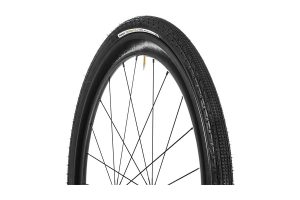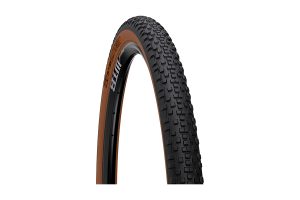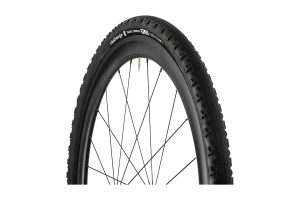The 8 Best Gravel Bike Tires in 2020
You have a gravel bike and the next thing you’re looking to upgrade (or replace) is the tires. When it comes to searching for gravel tires, some of the questions I always hear are,
- Should I go for a wider tire, say 37c?
- Which tires are the best?
- What type of tire threads should I get if I’m riding a mixture of gravel and tarmac roads?
- Are they grippy in the wet?
Now, deciding on the ideal gravel bike tire is not as straightforward as a road or mountain bike tire, because gravel bikes fall in between those two. It needs to perform well across a range of surface conditions making it challenging for tire manufacturers to come up with the ultimate tire.
On this page, I’ll discuss the things for you to consider in a pair of gravel tires and also share with you some of my favorite tires.
A Quick Glance : Our Favorite Tires for Gravel Bikes
Small Knobs Tires for Trails
Panaracer GravelKing SK
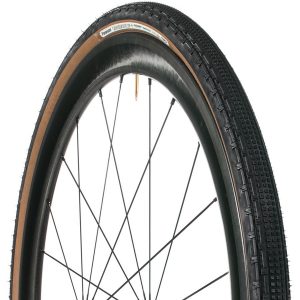
- Available Sizes : 650b, 700 x 32mm, 700 x 35mm, 700 x 38mm, 700 x 43mm, 700 x 50mm
- Colors : Black, Black/Brown
- Weight : 460g (700 x 38mm)
- Tubeless : Yes
When Japanese company Panaracer launched its line of GravelKing tires a few years back, they were lauded for their ability to handle gravel terrain while still offering a fast roll on paved roads.
This was thanks in large part to Panaracer’s ZSG natural rubber compound, which does a remarkable job of providing excellent traction without compromising roll.
The Panaracer GravelKing SK+, available in both 700c and 650b sizes, takes that to the next level with a heavier tread pattern and wider design that’s designed to take on gravel and dry single track as well as asphalt and pavement.
Its tread pattern is comprised of a tightly-packed low-profile knob in the middle for minimal resistance with much larger nubs on the sides for maximum traction on turns. With its low price point, the Panaracer GravelKing SK+ offers excellent value in a gravel tire.
- Pros : Available in both 650b and 700c sizes.
- Cons : Tubeless tires installation can be a challenge for beginners.
WTB Resolute
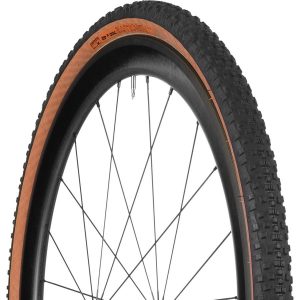
- Available Sizes : 650b, 700 x 42mm
- Colors : Tan/Copper
- Weight : 502g (700 x 42mm)
- Tubeless : Yes
WTB continues its reputation for developing affordable gravel and all-road tires with the WTB Resolute, its all-condition gravel tire.
The Resolute’s tire pattern is comprised of three different sections.
The center row is made of small square-shaped knobs that are designed to decrease rolling resistance. A wider set of knobs make up the tire’s intermediate and sides to offer better traction and mud-shedding capability on rougher terrain. Square knobs are designed to bite into the terrain when rising out of the saddle to climb.
The WTB Resolute is a somewhat wider tire at 42 mm, so be sure to check your frame’s clearance to see if they work with your rig. Both 700c and 650b sizes are available.
- Pros : Clears muds very well.
- Cons : Available only in 42mm width for 700c wheels.
Schwalbe G-One All Round
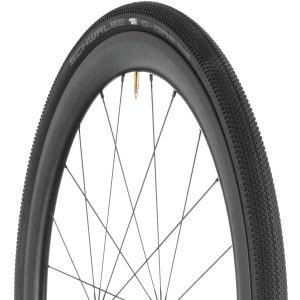
- Available Sizes : 650b, 700 x 35mm, 700 x 38mm
- Colors : Black
- Weight : 475g (700 x 38mm)
- Tubeless : Yes
German bicycle tire manufacturer Schwalbe uses densely-packed low-profile shoulder knobs on a rounded tire to provide traction on gravel and non-technical dry trails while at the same time offering a fast roll on pavement.
The aptly-named G-One All Round is an all rounder tire that uses a tread compound that makes these tires supple and sticky, resulting in excellent gripping power whether going uphill on off-road terrain or leaning into corners on the road.
The tire’s relatively large width of 35mm and 38 mm width provides excellent cushioning while Schwalbe’s Tubeless Easy construction makes the G-One All Around one of the easier tubeless tires to install.
- Pros : Very smooth and low rolling resistance.
- Cons : Doesn’t grip well in wet and muddy terrains.
Donnelly X'Plor MSO
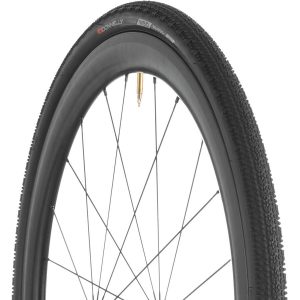
- Available Sizes : 700 x 36mm, 700 x 40mm
- Colors : Black
- Weight : 494g (700 x 36mm)
- Tubeless : Yes
Donnelly, a company specializing in building gravel and cyclocross bikes, offers an excellent tire for the rider to use on both pavements and off-road terrain with its X’Plor MSO tire.
Versatility comes from its tread design, which varies dramatically from inside to outside. The centerline tread is made up of densely packed treads that allow for a fast ride on smooth roads and hard-packed gravel. The sides are comprised of both large and small shoulder knobs designed to bite more deeply into the road, providing better traction on loose surfaces and in turns.
The X’Plor also offers more puncture resistance than many other tires with its multi-layer design. The trade-off for thick, more puncture-resistant tread is in weight and ride.
That extra rubber makes the Donnelly X’Plor MSO ride a bit stiffer while also adding bulk to the tires, which weigh in at a hefty 494g, which is significantly more than other models.
- Pros : Very good puncture protection properties.
- Cons : Heavier compared to its peers of similar size.
Hybrid Tires for Road and Trails
Challenge Gravel Grinder
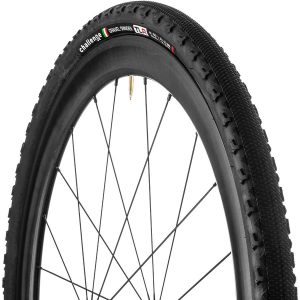
- Available Sizes : 700 x 33mm, 700 x 38mm, 700 x 42mm
- Colors : Black
- Weight : 364g (700 x 38mm)
- Tubeless : Yes
Italian company Challenge, which has been a staple in the cyclocross industry for a long time, expands into the world of gravel tires with this formidable clincher tire.
The Challenge Gravel Grinder is a hybrid tire that features a smooth center file tread with raised side knobs, giving it excellent rolling ability with grip for cornering. Vulcanized rubber provides added suppleness to this tire, while Challenge’s patented Double Puncture Protection System prevents you from having to pull over to change a flat.
For the weight weenies, this is among the lightest tires available today.
- Pros : Lightweight.
- Cons : Measures slightly wider than printed on the sidewalls.
Hutchinson Overide
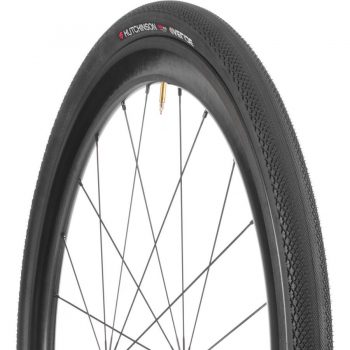
- Available Sizes : 700 x 35mm, 700 x 38mm
- Colors : Black
- Weight : 446g (700 x 38mm)
- Tubeless : Yes
Hutchinson, a 160-year-old French company, makes bicycle tires for all aspects of cycling including, recreational, mountain, cyclocross, and road bikes.
The Hutchinson Override is comprised of a slick-center tread coupled with low-profile diamond knobs on the sides for extra cornering traction. It’s designed with bead-to-bead reinforcement for puncture resistance, is tough enough to take on gravel roads but slick enough to provide good roll on smoother surfaces.
Low-profile tread makes this a good choice for hard-packed surfaces and dry conditions.
- Pros : Low rolling resistance for a fast and smooth ride.
- Cons : Limited sizes to choose from.
WTB Byway
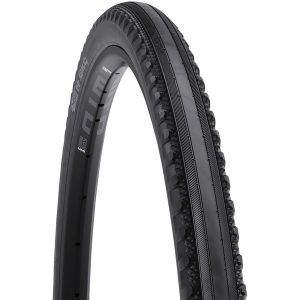
- Available Sizes : 700 x 34mm, 700 x 40mm, 700 x 44mm
- Colors : Black, Tan
- Weight : 439g (700 x 40mm)
- Tubeless : Yes
WTB is one of the pioneers of mountain bikes having built its first frame way back in 1982. This company understands how broadly road surfaces can vary for gravel riding.
A ride may go from pavement to fire road to gravel and back again in just a few miles. The WTB Byway is designed to handle those variances with its hybrid tread design. Specifically, it’s designed for 60% dirt roads and 40% pavement rides, and this can be clearly seen on its thread design.
This gravel tire offers a fast roll with its nearly slick center while the knobby sides offer plenty of traction to grip and hold gravel and other loose surfaces on turns.
It comes in 3 different sizes to suit your riding needs. Go narrower for speed, or wider for comfort.
- Pros : Unique thread patterns designed for both tarmac and gravel terrains.
- Cons : Doesn’t grip too well in wet and muddy terrains.
Vittoria Terreno Zero G2.0
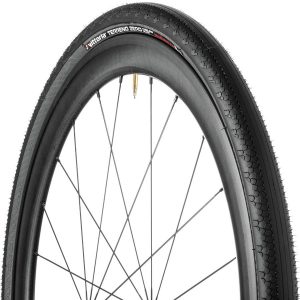
- Available Sizes : 700 x 35mm, 700 x 38mm
- Colors : Black, Anthracite
- Weight : 428g (700 x 35mm)
- Tubeless : Yes
Vittoria, one of the most well-respected tire makers in the market, makes its first foray into the gravel market with the Vittoria Terreno Zero G2.0. And it’s a good one.
The Terreno Zero combines two different tread styles to offer both traction and good roll. The semi slick center tread is inherited from its Corsa road bike tires that allow for good roll on compact surfaces, while heavier side knobs on the sides provide good traction for braking and turns.
More importantly, it also features Vittoria’s patented 3C Graphene 2.0 compound structure, which combines graphene with rubber to make a faster tire. Its TNT casing technology allows for easier tubeless tire set up compared to other brands.
- Pros : Soft rubber compounds make installation easier.
- Cons : Only available in 2 sizes.
Gravel Bike Tires Buying Guide
In this section, I’ll share 5 things to consider before you buy your next set of gravel tires.
1. Tire Width
When riding on off-road terrain, a wider tire is going to offer you better traction and comfort.
Wider tires provide more shock-absorbing cushion between you and the roadway as well as more contact with the road surface, resulting in better traction.
The downside to width is weight and drag.
Wider tires have more material and are thus heavier than skinnier road bike tires. This also means they won’t roll as quickly on paved surfaces. Just think about how sluggish your mountain bike rides on the road compared to your road bike.
So how wide is wide enough for a gravel tire?
A range of 38mm to 42mm width on a 700c tire is an ideal width, providing enough tread to handle the terrain while keeping the weight at a reasonable level. If you’re running a 650b wheelset, then the ideal size is between 45mm to 50mm wide.
2. Wheel Size
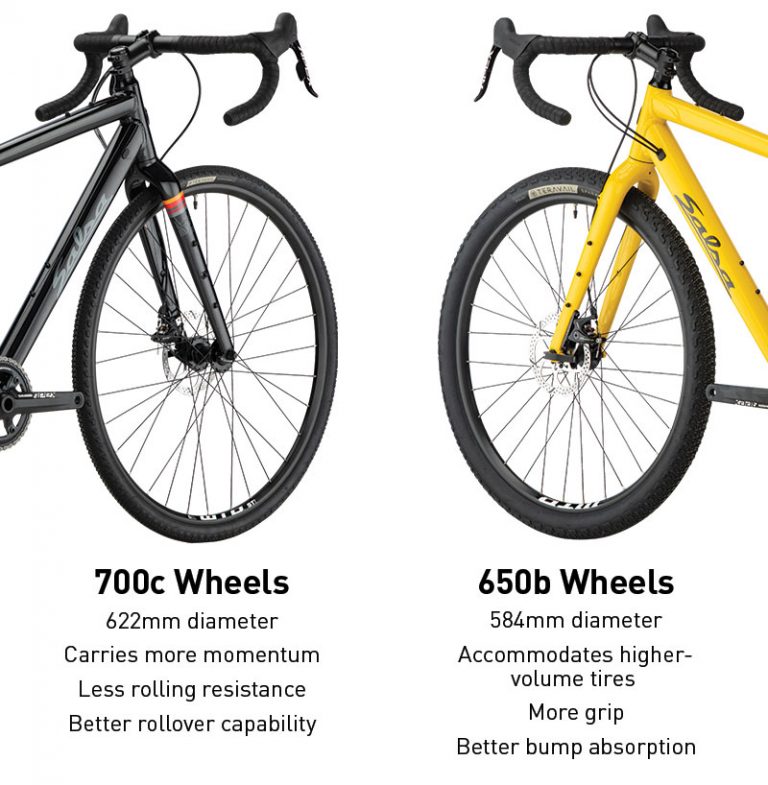
Wheel size was once pretty standard here as the bulk of gravel bikes came with 700c wheels.
Lately; however, the 650b wheel size has become more popular.
Once exclusively used by French touring bikes and later on hardtail mountain bikes, manufacturers such as Schwalbe, Panaracer, and WTB have recently begun using the 650b wheel size in their gravel tire designs.
The smaller wheel size allows for a much fatter tire while keeping the overall diameter of the wheel about the same as a 700c wheel with a thinner tire.
This means that the diameter of a 650b x 47mm tire equals a 700 x 28mm tire. The 650b size gives you the ability to ride wider tires at lower air pressures, maximizing comfort, and traction.
While 650b is still relatively new to gravel riding, more and more manufacturers are jumping on the bandwagon with the likes of Panaracer Gravel King SK+, Schwalbe G-One, and WTB Resolute all available in both 700c and 650b sizes.
3. Tire Tread
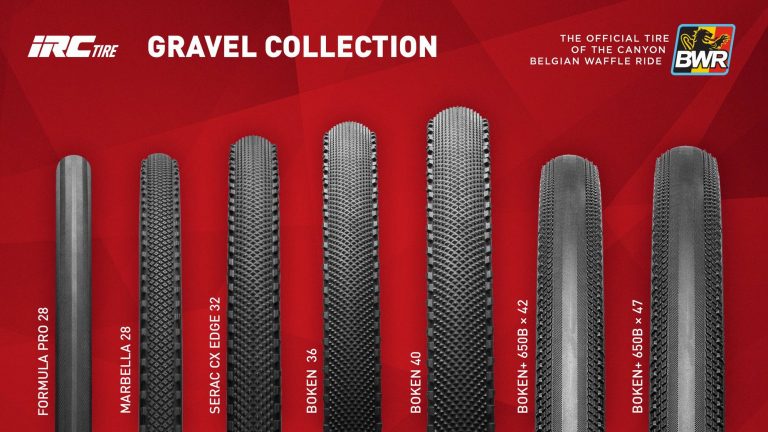
Remember those old Secret deodorant commercials that touted their product as strong enough for a man, but made for a woman.
That’s sort of the idea with gravel tires, which need to be knobby enough for off-road terrain but smooth enough to offer good roll on packed and paved surfaces.
In general, there are 3 types of tire threads.
Slicks
These are designed for paved surfaces and tightly packed fine gravel as they’ll provide you with the quickest roll.
However, don’t expect much traction though. Slicks can’t handle rough or wet terrains very well.
Small Knobs
You’ll need this tread pattern if you plan on riding over rougher gravel terrain.
Those such as the Panaracer GravelKing SK+ or the Schwalbe G-One feature tread with knobs that are compact and shallow enough to provide good roll on the smoother ground paved surfaces while providing just enough tread for grip on rough terrain.
Hybrid
The unique design of hybrid tires such as the Challenge Gravel Grinder or Hutchinson Override blends slick tires’ efficiency with knobby tires’ gripping action. These tires are built on the idea that tread is most crucial when turning.
The center tread on hybrid tires features smooth or reduced tread, allowing for a more efficient roll, while the side blocks feature larger knobs for gripping while executing turns on loose terrain.
4. Clincher vs Tubeless
More and more gravel riders see the huge advantages that tubeless tires have to offer due to their puncture protection qualities and improved grip and comfort.
There’s also no risk of pinching a tube with tubeless tires and when used in conjunction with a tubeless sealant, it won’t flat even when punctured. Simply put, and you’ll more than likely, never have to change a tubeless tire on the side of the road.
Why the better traction and comfort?
Tubeless tires can run on low tire pressure. Lower pressure means tires can adhere and grip gravel surfaces instead of bouncing over them. This results in better traction and a smoother ride.
Tubeless tires do have their downsides, though.
Installation can be a struggle. Just getting a tubeless tire on a rim can be quite a challenge, even with tire levers. Once on the rim, getting a tubeless tire to seat usually requires a high-volume floor pump or air compressor.
Tubeless tire companies are, however, finding ways of making this easier. With their TNT tire wall technology, companies such as Vittoria are making mounting and inflating these tires much easier.
5. Frame and Fork Clearance
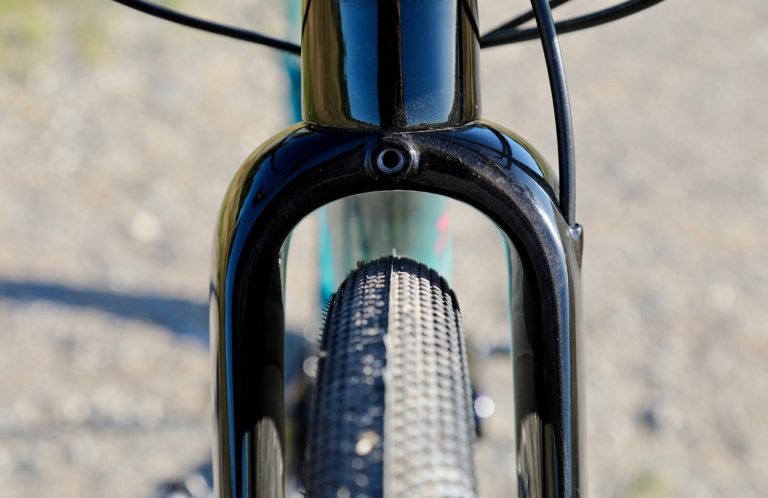
If wider tires mean more comfort, shouldn’t you go for the widest available tires?
Technically yes. But there is another factor to consider.
You’ll want to ensure that there is enough frame clearance to handle the extra millimeters added to your wheels’ diameter. This shouldn’t concern the latest gravel bike models since they are designed to support fatter tires.
Gravel bikes can typically handle tires up to 700 x 42mm or 650 x 49mm.
However, if you plan on converting your old or cheap road bike into a gravel bike, you’ll need to check your frame and fork size to make sure they have enough clearance to handle the larger wheel diameter.
It would be best if you had at least 3mm of clearance between your tires and the frame or fork to ensure you don’t have any wheel rub, which could damage the bike frame in the long run.
Author Recommended Reads

